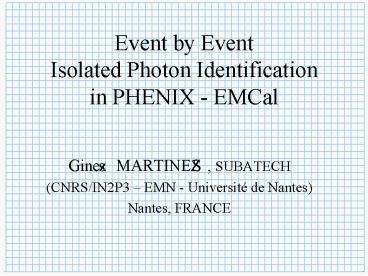Event by Event Isolated Photon Identification in PHENIX EMCal - PowerPoint PPT Presentation
1 / 38
Title:
Event by Event Isolated Photon Identification in PHENIX EMCal
Description:
Singles. Gines MARTINEZ, Subatech. PHENIX Meeting. Palaiseau ... Free parameter amax : amax between 0.8-0.9. Expected Ratio ('fake direct') from p0 real data : ... – PowerPoint PPT presentation
Number of Views:31
Avg rating:3.0/5.0
Title: Event by Event Isolated Photon Identification in PHENIX EMCal
1
Event by Event Isolated Photon Identification
in PHENIX - EMCal
- Gine MARTINE , SUBATECH
- (CNRS/IN2P3 EMN - Université de Nantes)
- Nantes, FRANCE
s Z
z S
s Z
2
Preface
- This is a short presentation about the PHENIX
EMCal capabilities to identify high pT photons. - PISA simulation results.
- I know QM2002 new results are more interesting.
- But, we are in Palaiseau and we have to make a
full afternoon of French PHENIX presentations. - An analysis note soon.
- Good reading after QM2002.
3
Motivations Reality
- We want to measure direct photons.
- pT range 1 25 GeV/c
- We want to reject meson decay photons.
- we can always dream
- The kinematics of the electromagnetic meson decay
is what it is. - The electromagnetic calorimeter is a real
detector. - Acceptance, Thresholds, Reconstruction, PID, etc
- Our environment is not very clean .
- Large Combinatorial Background, High Multiplicity
Environment.
4
Outlook
- Kinematics
- Maximum Asymmetry Parameter
- Algorithm Spectroscopic Isolation Cut Analysis
(SIC) - Isolated percentage ISOLATED/CANDIDATES
- Flat distribution
- Power-law distribuion
- p0 energy estimation.
- Energy Threshold.
- High Multiplicity Environment.
- Direct Photon Excess Extraction.
- Conclusions.
5
Kinematics of the p0 decay
6
Relative Opening Angle
Relative opening angle (rad)
7
Asymmetry Parameter
- Looking for a companion photon within a 100
acceptance disk Cone inside EMCal - Invariant Mass Analysis Spectrometer better than
Calorimeter (Spectroscopic). - Asymmetry as a parameter amax
- Independent on p0 initial energy
- Asymmetry as probability
- Compromise Acceptance vs Rejection
- amax 0.6, 0.7, 0.8, 0.9 and 0.95
8
The algorithm
- For each photon i
- Look if the disk (cone projection on EMCal) of
radius Ri(amax(Ep)) around the center of the
photon cluster, is inside EMCal - if Yes ? Photon Candidate
- Looking for photon companion j for which the
minvij100-160 MeV/c2. - if No ? Isolated Photon (it could be a fake
direct or a real direct photon). - Studying the ratio
- Ratio (dNiso/dEg) / (dNcan/dEg)
9
Mono energetic p0
amax 0.9, RatioNiso/Ncan0.1 amax 0.8,
RatioNiso/Ncan0.2
10
Direct Photon Excess
p0
11
Flat Distribution (E1 , E2)
Ratio Niso/Ncan
12
PISA Simulations
- pT 0 - 12 GeV/c
- -0.5lt h lt0.5
- 0 lt j lt 2p
- Flat distribution
- Power Law 1/En,
- n7.02 (p0 _at_ 130A GeV)
13
Flat p0 Simulation in EMCal
candidates
isolated
amax 0.6
amax 0.7
amax 0.9
amax 0.8
14
Ratio for a Flat p0 Simulation
amax 0.6
amax 0.7
Ratio Niso/Ncan
amax 0.9
amax 0.8
Ratio Niso/Ncan
15
Power Law Distribution
n7.02 AuAu _at_ 130A GeV
Ratio Niso/Ncan
16
Power Law p0 Simulation
amax 0.6
amax 0.7
candidates
isolated
amax 0.9
amax 0.8
17
Ratio for a Power Law
amax 0.6
amax 0.7
Ratio Niso/Ncan
amax 0.9
amax 0.8
Ratio Niso/Ncan
18
Realistic Algorithm
- Initial p0 energy is unknown
- High Multiplicity environment
- Energy threshold of the detector
19
p0 energy estimation
20
With Without p0 energy estimation
FLAT
Ratio Niso/Ncan
Without
With
amax 0.7
amax 0.8
amax 0.9
amax 0.95
Ratio Niso/Ncan
21
With Without p0 energy estimation
POWER LAW
Without
Ratio Niso/Ncan
With
amax 0.7
amax 0.8
amax 0.9
amax 0.95
Ratio Niso/Ncan
22
High Multiplicity Environment
- Combinatorial Background Simulation
- Power law background
- 50 p0s per rapidity unit (peripheral)
- 300 p0s per rapidity unit (central)
Embedded (raw-rel mixing) with
The single p0 uniformly distributed, and
power-law weighted
23
Low Occupancy (Peripheral)
amax 0.7
amax 0.8
Singles
Ratio Niso/Ncan
Embedded
amax 0.9
amax 0.95
Ratio Niso/Ncan
24
High Occupancy (Central)
amax 0.7
amax 0.8
Singles
Ratio Niso/Ncan
Embedded
amax 0.9
amax 0.95
Ratio Niso/Ncan
25
Threshold Energy
26
Energy Threshold
amax 0.7
amax 0.8
Ratio Niso/Ncan
amax 0.9
amax 0.95
Ratio Niso/Ncan
27
Realistic SIC Analysis
- Initial p0 energy is unknown
- High Multiplicity environment
- Energy threshold of the detector
28
Realistic SIC p0 analysis (pp)
amax 0.7
amax 0.8
Ratio Niso/Ncan
amax 0.9
amax 0.95
Ratio Niso/Ncan
29
Realistic SIC p0 analysis (periph)
amax 0.7
amax 0.8
Ratio Niso/Ncan
amax 0.9
amax 0.95
Ratio Niso/Ncan
30
Realistic SIC p0 analysis (central)
amax 0.7
amax 0.8
Ratio Niso/Ncan
amax 0.9
amax 0.95
Ratio Niso/Ncan
31
Realistic g SIC analysis (pp)
amax 0.7
amax 0.8
Ratio Niso/Ncan
amax 0.95
amax 0.9
Ratio Niso/Ncan
32
Realistic g SIC analysis (periph)
amax 0.7
amax 0.8
Ratio Niso/Ncan
amax 0.95
amax 0.9
Ratio Niso/Ncan
33
Realistic g SIC analysis (central)
amax 0.7
amax 0.8
Ratio Niso/Ncan
amax 0.95
amax 0.9
Ratio Niso/Ncan
34
More about Photon Excess Extraction
35
Photon Excess
36
Conclusions
- High Photon Identification (SIC).
- Free parameter amax
- amax between 0.8-0.9
- Expected Ratio (fake direct) from p0 real data
- 0.4 - 0.7
- When can SIC be applied?
- Low occupancy
- pT gt 3 GeV/c for amax0.8
- pT gt 5 GeV/c for amax0.9
- High occupancy pT
- pT gt 5 GeV/c for amax0.8
- pT gt 7 GeV/c for amax0.9
37
Quark Matter 2002
QM2002 Preliminary
Enjoy !
38
Weather in Nantes































